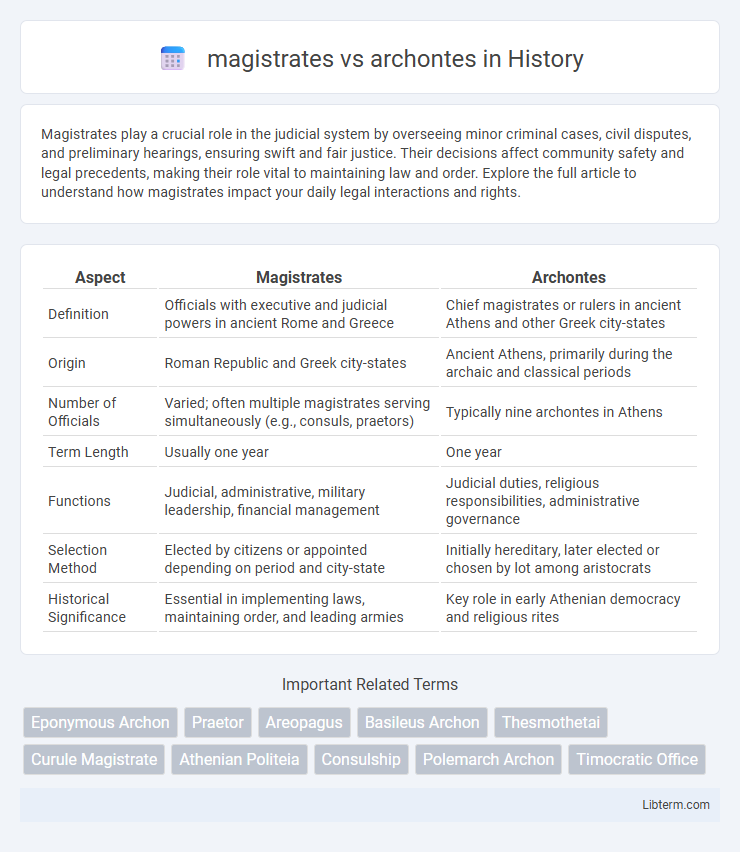Magistrates play a crucial role in the judicial system by overseeing minor criminal cases, civil disputes, and preliminary hearings, ensuring swift and fair justice. Their decisions affect community safety and legal precedents, making their role vital to maintaining law and order. Explore the full article to understand how magistrates impact your daily legal interactions and rights.
Table of Comparison
| Aspect | Magistrates | Archontes |
|---|---|---|
| Definition | Officials with executive and judicial powers in ancient Rome and Greece | Chief magistrates or rulers in ancient Athens and other Greek city-states |
| Origin | Roman Republic and Greek city-states | Ancient Athens, primarily during the archaic and classical periods |
| Number of Officials | Varied; often multiple magistrates serving simultaneously (e.g., consuls, praetors) | Typically nine archontes in Athens |
| Term Length | Usually one year | One year |
| Functions | Judicial, administrative, military leadership, financial management | Judicial duties, religious responsibilities, administrative governance |
| Selection Method | Elected by citizens or appointed depending on period and city-state | Initially hereditary, later elected or chosen by lot among aristocrats |
| Historical Significance | Essential in implementing laws, maintaining order, and leading armies | Key role in early Athenian democracy and religious rites |
Introduction to Magistrates and Archontes
Magistrates in ancient Greece were public officials responsible for the administration of justice and various governmental duties, often elected or appointed based on civic qualifications. Archontes, a specific category of magistrates primarily in Athens, served as chief magistrates overseeing judicial, military, and religious functions during Classical Antiquity. The distinction between magistrates and archontes lies in the archontes' specialized roles and prominence in governance, reflecting early forms of organized political authority in Greek city-states.
Historical Origins of Magistrates and Archontes
Magistrates originated in the Roman Republic as elected officials responsible for administration and justice, with roles such as consuls and praetors evolving from early republican governance structures. Archontes, rooted in ancient Athens, served as chief magistrates overseeing judicial and religious duties, initially drawn from aristocratic families before becoming elected positions in classical democracy. Both institutions reflect early systems of civic authority, with magistrates embodying Roman legal order and archontes representing Athenian political and religious leadership.
Roles and Responsibilities: Magistrates vs. Archontes
Magistrates held judicial and administrative authority in ancient Greek city-states, overseeing legal disputes, public order, and fiscal management to ensure governmental stability. Archontes, as prominent magistrates, specifically managed religious ceremonies, legal judgments, and presided over the assembly, reflecting a blend of sacred and civic duties central to Athenian governance. Their distinct responsibilities highlight the segregation of powers, where magistrates administered broad executive functions while archontes focused on key judicial and ceremonial roles.
Appointment and Selection Processes
Magistrates in ancient Rome were typically elected through a formal voting system involving Roman citizens, emphasizing public participation and accountability. Archontes in classical Athens were chosen by a mix of election and sortition, often combining citizen voting and random selection to balance merit and equality. The Roman magistracy prioritized hierarchical rank and career progression, whereas Athenian archontes selection emphasized democratic principles and equal opportunity among eligible citizens.
Judicial Powers and Authority
Magistrates in ancient Greece wielded extensive judicial powers, overseeing civil and criminal cases with authority derived from city-state governance structures. Archontes, particularly in Athens, functioned as chief magistrates with specialized judicial roles such as presiding over homicide trials and religious courts. The differentiation in judicial authority between magistrates and archontes reflects a structured hierarchy where magistrates had broader administrative duties while archontes held specific, often prestigious, judicial mandates.
Political Influence and Governance
Magistrates held significant political influence in ancient Greek city-states by administering laws, overseeing public finances, and commanding military forces, thereby shaping governance directly. Archontes, often hereditary or elected officials, served as chief magistrates with both judicial and executive powers, influencing policy-making and maintaining civic order. The power dynamics between magistrates and archontes varied, with magistrates frequently executing daily governance while archontes played prominent roles in ceremonial leadership and legal adjudication.
Duration of Terms in Office
Magistrates in ancient Rome typically held office for one year, ensuring regular accountability and rotation of power among the elite. In contrast, Greek archontes, particularly in Athens, originally served for ten years but later transitioned to annual terms to promote broader participation in governance. The shift in term duration reflects differing political structures and priorities between Roman and Greek city-states regarding administrative stability and democratic inclusion.
Regional and Cultural Differences
Magistrates in ancient Rome held formal judicial and administrative roles defined by Roman law, primarily operating within structured urban and regional governance systems. In contrast, archontes in ancient Greece, particularly Athens, functioned as chief magistrates with varying religious, judicial, and military duties shaped by the polis's cultural and political institutions. Regional distinctions highlight that magistrates were integrated into Rome's hierarchical legal framework, while archontes embodied a fusion of civic and sacred authority reflecting localized Hellenic traditions.
Legacy and Impact on Modern Systems
Magistrates in Roman law laid the foundation for modern judicial and administrative roles, influencing contemporary legal frameworks through codified statutes and public accountability. Archontes in ancient Athens contributed to democratic governance by balancing power among elected officials, shaping today's notions of checks and balances in political institutions. Both magistrates and archontes have left enduring legacies that inform modern concepts of leadership, legal authority, and civic responsibility across Western legal and political systems.
Comparative Analysis: Magistrates vs. Archontes
Magistrates and archontes both served as key judicial and administrative officials in ancient Greek city-states, but magistrates typically held broader executive powers and often functioned within a more structured legal framework. Archontes were primarily Athenian officials with specific religious, military, or judicial roles, often limited to annual terms that emphasized civic rotation and accountability. Comparative analysis reveals magistrates wielded greater administrative authority, while archontes embodied a blend of political leadership and ceremonial duties crucial to the polis's religious and social order.
magistrates Infographic

 libterm.com
libterm.com